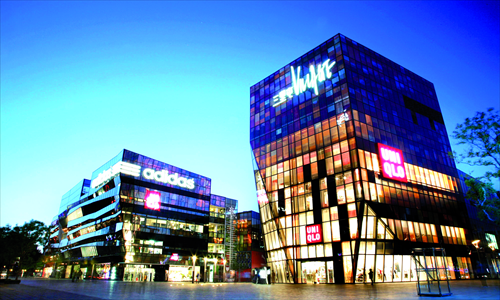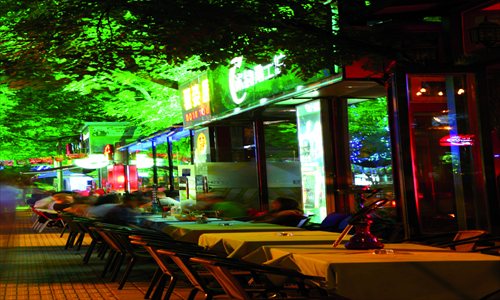HOME >> METRO BEIJING
Sanlitunization
By Matthew Jukes Source:Global Times Published: 2012-4-9 19:25:03



What and where is Sanlitun in your opinion? Photos: CFP
It has become a foreign haven, a microcosm in a large metropolis. Businesses are at home in the glitzy glass office blocks, conveniently surrounded by hundreds of foreign-style cafés, and expats are even more at home, flocking to the area to sate their cravings for cheap Tsingtao beer, sleazy nightclubs and grubby takeaways.
This is the Sanlitun we know today, an almost ghetto-like enclosure that is entirely possible never to leave as an expat in Beijing. But the area that many know as Sanlitun, or even as home, is far removed from what it once was.
Back in the day
The original small district of Sanlitun, which covered the community and compounds located along the Sanlitun North, South, East and West streets, was named for its three "li" distance from the city's northeastern gate at Dongzhimen (the Second Ring Road being where the original city wall was).
The area became a haven for overseas visitors after the founding of the People's Republic of China in 1949. The destroyed city walls were no longer an issue for the growth of Beijing, and when seeking to move the foreign delegations from the old Legation Quarter near Tiananmen Square, perhaps after the disastrous siege by the Boxer Rebellion (1898-1901), Sanlitun seemed like the perfect location.
Some still stick to these parameters when they talk about Sanlitun. "I think the village is really it for Sanlitun, maybe 200 meters either side. Xindong Lu is really out of Sanlitun on the side - that's as far as it goes," says Nicholas Bonner, who currently runs Koryo Tours, which is based in the Sanlitun area. Bonner is a long-time resident of Sanlitun. "Me and Alex Pearson [of The Bookworm fame] actually started Poachers in 1993, one of the first bars in the area. There was a bar near Workers' Stadium called Frank's Place. Jenny Lou's started there too, with a little outside market selling food for the Italian Embassy." Bonner was amongst the trailblazers of Bar Street. The memory of the tiny street is clearly a fond one. "There were no bars or places to have a drink, even in restaurants," he adds. "The whole place is all Chinese-owned now, not expat-owned. It had its time, when it was sort of creative. I think it brought social drinking to China."
More than three li
Whether it is creative or not, it is still definitely having a good time. Consequently, you'll find businesses clinging to the advertising power of Sanlitun almost as far away as Dongsishitiao. Sanlitun Kindergarten, for one, is closer in proximity to Chaoyangmen behind Worker's Stadium and yet retains the name. Even several government sub-district offices for the Sanlitun area are situated well away from the main drag.
"If people are using the name Sanlitun as an advertisement, they're not doing it as some kind of deception," says Ma Tian, of the Beijing Tourist Information Center. "Sanlitun is just something that has become well-known and synonymous with the foreign community. So by using the district's name, they're just trying to make the type of location easily understood." Indeed, the advertising potential of the area has not gone unnoticed by the powers that be. On April 6 last week, our reporters discovered that many of the city's landmarks were encouraged to register for their own trademarks. On the list amongst Beijing's hutong and famous relics was Sanlitun Bar Street.
"Actually I think Sanlitun is one of the more famous districts of Beijing, particularly when it comes to food and entertainment," says Jing Chen, who works at the Sanlitun Youth Hostel, which is situated on Chunxiu Lu, outside the original Sanlitun catchment area. "From here, if you're looking to walk to Bar Street, it'll only take around 10 minutes."
Jing suggests that the 10 to 15 minute walking distance from the famous street is what could in theory define what area is actually "Sanlitun," and notes that there are limits, crossing the Third Ring Road being one of them. "Apart from Workers' Stadium, it's the best-known landmark in the area. For our guests, it's the most convenient location to name. As long as they always know Bar Street, and Sanlitun, they'll know where they are," he added.
Buying into the brand
It seems Sanlitun has a certain weighty quality. The comfort of the bar strip, and the Western shops and restaurants that have sprung up around it, has drawn the expat community to live in the area. While it started as a convenient place for diplomats and embassy staff, demand is now high, as are rents, and even the older buildings are kitted out with modern, Western standard amenities.
And today it's not just foreigners who are aiding the perceived expansion of the Sanlitun catchment area, but young Chinese too. Wu Jingke runs the Lin Ze real estate agency in Xingfucun Zhonglu, just a stone's throw from the official Sanlnitun district. "It has become very fashionable just to be near Bar Street. All you can see are fashionable, young people in their 20s and 30s wandering around the area for shopping and socializing," says Wu. "A lot of places want to attract this young, rich group, and they'll use the popular Sanlitun name to do it." Wu still sticks by the original parameters of Sanlitun. "In reality the Sanlitun area is still the same; everything from the new Shimao department store to the Third Ring Road, and Dongzhimenwai in the north to Sanlitun South Street." However, to what extent other people stick by these parameters is more blurred.
Toyomi Kuramoto contributed to this story
This is the Sanlitun we know today, an almost ghetto-like enclosure that is entirely possible never to leave as an expat in Beijing. But the area that many know as Sanlitun, or even as home, is far removed from what it once was.
Back in the day
The original small district of Sanlitun, which covered the community and compounds located along the Sanlitun North, South, East and West streets, was named for its three "li" distance from the city's northeastern gate at Dongzhimen (the Second Ring Road being where the original city wall was).
The area became a haven for overseas visitors after the founding of the People's Republic of China in 1949. The destroyed city walls were no longer an issue for the growth of Beijing, and when seeking to move the foreign delegations from the old Legation Quarter near Tiananmen Square, perhaps after the disastrous siege by the Boxer Rebellion (1898-1901), Sanlitun seemed like the perfect location.
Some still stick to these parameters when they talk about Sanlitun. "I think the village is really it for Sanlitun, maybe 200 meters either side. Xindong Lu is really out of Sanlitun on the side - that's as far as it goes," says Nicholas Bonner, who currently runs Koryo Tours, which is based in the Sanlitun area. Bonner is a long-time resident of Sanlitun. "Me and Alex Pearson [of The Bookworm fame] actually started Poachers in 1993, one of the first bars in the area. There was a bar near Workers' Stadium called Frank's Place. Jenny Lou's started there too, with a little outside market selling food for the Italian Embassy." Bonner was amongst the trailblazers of Bar Street. The memory of the tiny street is clearly a fond one. "There were no bars or places to have a drink, even in restaurants," he adds. "The whole place is all Chinese-owned now, not expat-owned. It had its time, when it was sort of creative. I think it brought social drinking to China."
More than three li
Whether it is creative or not, it is still definitely having a good time. Consequently, you'll find businesses clinging to the advertising power of Sanlitun almost as far away as Dongsishitiao. Sanlitun Kindergarten, for one, is closer in proximity to Chaoyangmen behind Worker's Stadium and yet retains the name. Even several government sub-district offices for the Sanlitun area are situated well away from the main drag.
"If people are using the name Sanlitun as an advertisement, they're not doing it as some kind of deception," says Ma Tian, of the Beijing Tourist Information Center. "Sanlitun is just something that has become well-known and synonymous with the foreign community. So by using the district's name, they're just trying to make the type of location easily understood." Indeed, the advertising potential of the area has not gone unnoticed by the powers that be. On April 6 last week, our reporters discovered that many of the city's landmarks were encouraged to register for their own trademarks. On the list amongst Beijing's hutong and famous relics was Sanlitun Bar Street.
"Actually I think Sanlitun is one of the more famous districts of Beijing, particularly when it comes to food and entertainment," says Jing Chen, who works at the Sanlitun Youth Hostel, which is situated on Chunxiu Lu, outside the original Sanlitun catchment area. "From here, if you're looking to walk to Bar Street, it'll only take around 10 minutes."
Jing suggests that the 10 to 15 minute walking distance from the famous street is what could in theory define what area is actually "Sanlitun," and notes that there are limits, crossing the Third Ring Road being one of them. "Apart from Workers' Stadium, it's the best-known landmark in the area. For our guests, it's the most convenient location to name. As long as they always know Bar Street, and Sanlitun, they'll know where they are," he added.
Buying into the brand
It seems Sanlitun has a certain weighty quality. The comfort of the bar strip, and the Western shops and restaurants that have sprung up around it, has drawn the expat community to live in the area. While it started as a convenient place for diplomats and embassy staff, demand is now high, as are rents, and even the older buildings are kitted out with modern, Western standard amenities.
And today it's not just foreigners who are aiding the perceived expansion of the Sanlitun catchment area, but young Chinese too. Wu Jingke runs the Lin Ze real estate agency in Xingfucun Zhonglu, just a stone's throw from the official Sanlnitun district. "It has become very fashionable just to be near Bar Street. All you can see are fashionable, young people in their 20s and 30s wandering around the area for shopping and socializing," says Wu. "A lot of places want to attract this young, rich group, and they'll use the popular Sanlitun name to do it." Wu still sticks by the original parameters of Sanlitun. "In reality the Sanlitun area is still the same; everything from the new Shimao department store to the Third Ring Road, and Dongzhimenwai in the north to Sanlitun South Street." However, to what extent other people stick by these parameters is more blurred.
Toyomi Kuramoto contributed to this story
Posted in: Metro Beijing